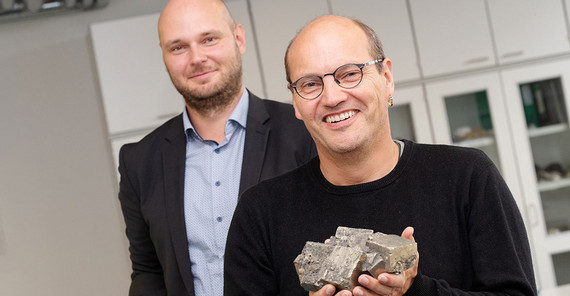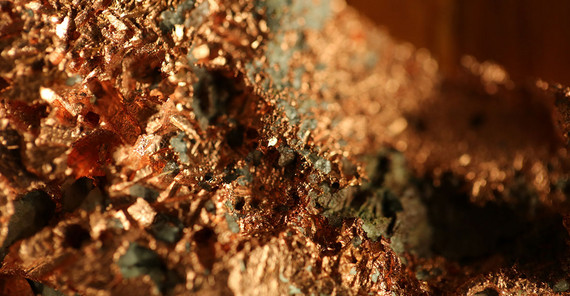The highest mountain is only 1,214 meters high. Although the small Ore Mountains cannot compete with the mighty mountain ranges of the world, they boast other qualities that are reflected in their name. The mountain formation is several hundred million years old and is considered the cradle of numerous mineral resources such as silver, tin, tungsten, and iron. Important geological processes, which have created numerous important deposits of various ores, can be studied here in a comparatively small area.
A look into the history of the Earth
The mountains are therefore a veritable open-air laboratory that is practically on the doorstep for geoscientists from Germany. In summer 2021, around 30 researchers and doctoral students took the opportunity to spend five days exploring what can be found above and below ground. Most of them had just started research projects in the large-scale research program "Dynamics of Ore Metals Enrichment" (DOME). The excursion was a prelude and a belated opportunity to get to know each other: it had actually been planned a year earlier but had to be postponed due to the Corona pandemic.
“In the Ore Mountains, you can walk from the center of the former magma chamber up to the former surface of the earth within a day,” explains the coordinator of the priority program, geoscientist Maximilian Korges. The geologically most interesting spots are where the magma chamber meets the surrounding rock: This is where many different ore minerals formed over millions of years. Seeing the rock structures and formations with your own eyes is highly informative, especially for those who usually work in a lab or at a desk. “It is particularly valuable for young researchers to look beyond their own horizons and gain skills outside their own field of work,” Korges emphasizes.
Three years and 50 publications
DOME started in 2020 with 26 research projects involving institutes from all over Germany. “First of all, it’s about understanding how ores form,” explains DOME spokesperson Max Wilke, Professor of Mineralogy. “This has not been done in this way in Germany or anywhere else for a very long time.” However, basic research also provides important findings for later application - i.e. the development of new ore deposits and their extraction. “Then you know where to look or what data you need in order to find new deposits,” Prof. Wilke sums up.
The researcher looks back on the positive developments of the past three years. “We have already published 50 papers resulting from our projects although many of them have not even been completed yet. And we have been successfully networking both nationally and internationally.” In order to train and promote young researchers, the DOME research network not only offers field-related studies but also workshops on experimental methods and mathematical modeling, seminars on presentation techniques, or on writing a scientific publication.
“All German universities and research institutions in our field of research are represented with projects in DOME,” Prof. Wilke is happy to report. The research projects represent an immense variety of special fields and are conducted all over the world: from Germany, Portugal, China, Poland, Greece, Finland, the USA, Namibia, Brazil, Canada to the world’s oceans. The methods are as diverse as the places of research and include experiments in the laboratory, field studies and expeditions as well as computer modelling.
New projects for the second funding period
In Potsdam, for example, laboratory experiments are being conducted to investigate how molybdenum minerals behave in hot aqueous solutions. How much molybdenum, which is mainly used for steel production, dissolves at what pressure and temperature? In what condition is it present in the solution, and which parameters influence these processes? The researchers want to use the experiments to get a better understanding of the conditions under which these minerals are formed. This will make it easier to identify areas around the world with similar properties and potential molybdenum deposits. The chemical experiments also reveal how to better dissolve the material and separate individual metals in the ore mixture. In the future, the findings may also help to better process ores or make the metals usable again through subsequent recycling.
A doctoral student from Erlangen took part in a two-month research cruise and analyzed samples from underwater volcanoes to investigate mineralization processes at hot springs on the seabed, where boiling liquids, magmatic gases, and cold seawater meet. In the Ore Mountains, on the other hand, the researchers carry out field tests to understand the formation of tin ores. Numerical simulations help to model and understand the processes that take place in the magma chamber and the surrounding area over millions of years. “We can see the final product in the form of ore, but we don’t know what happened before. Computer simulations can help us to take a look into the past,” Korges explains.
The DOME project has now entered its second funding period until 2026 with 26 new projects and new research teams. The two project leaders from Potsdam agree that this field of research is likely to become increasingly important in the next decades because the global demand for many valuable elements found in ores, such as germanium, lithium, copper, and cobalt, will increase. After all, they are indispensable for key technologies in energy transition and digitalization. At the same time, geopolitical crises are exacerbating supply uncertainties. This makes it all the more important to strengthen research in this field in the coming years, train young researchers, and improve networking within the community.
Molybdenum
The transition metal molybdenum is found in various ores such as molybdenum disulfide (molybdenum glance), wulfenite (yellow lead ore) or powellite (calcium molybdate). In complex chemical processes, the molybdenum is separated from the accompanying minerals, then roasted at high temperatures of several hundred degrees Celsius, freed from further impurities, and reduced to molybdenum powder with the help of hydrogen in two further processing stages. In 2020, 240,000 tons of molybdenum, which is mainly used for metal alloys and in steel production, were produced worldwide.
The Researchers
Prof. Dr. Max Wilke has been group leader of the working group Mineralogy at the Institute for Geosciences of the University of Potsdam since 2015.
Email: max.wilkeuuni-potsdampde
Dr. Maximilian Korges has been a Postdoctoral Researcher in the working group Mineralogy at the Institute for Geosciences of the University of Potsdam since 2020.
Email: maximilian.korgesuuni-potsdampde
The Project
The Priority Program “Dynamics of Ore Metals Enrichment” (DOME) (SPP 2238) is funded by the German Research Foundation (DFG). The research projects investigate the dynamics of ore-metals enrichment in nature. With the help of empirical field studies, experimental work, and numerical process modeling, the researchers are creating new foundations for the exploration of deposits in deep layers of earth.
Duration: 2020–2026
Participants: University of Potsdam, Universität Bayreuth, University of Bremen, Leibniz University Hannover, Johannes Gutenberg University Mainz, GeoZentrum Nordbayern, Friedrich-Alexander Universität Erlangen-Nürnberg, TU Bergakademie Freiberg, GEOMAR Kiel, Goethe University Frankfurt (M), University of Freiburg, RWTH Aachen, University of Tübingen, The Helmholtz Centre Potsdam - GFZ German Research Centre for Geosciences, University of Cologne, University of Münster, Karlsruhe Institute of Technology, Helmholtz-Institute Freiberg for Resource Technology.
Funding: German Research Foundation (DFG)
Link to the project:https://www.uni-potsdam.de/en/spp2238
This text was published in the university magazine Portal Wissen - Eins 2024 „Bildung:digital“ (PDF).


